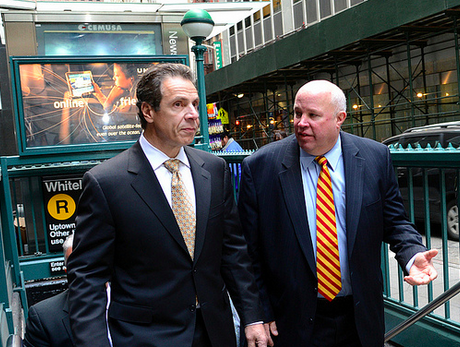If you were hoping the release of the MTA Reinvention Commission report would be the moment when Governor Andrew Cuomo comes to his senses and makes an aggressive push to fund the region's transit system by fixing its dysfunctional tolling structure, don't hold your breath.

Yesterday, Dana Rubinstein at Capital New York published a draft copy of the report [PDF 1, 2, 3]. While the MTA won't say when the commission plans on releasing the final version, it should be coming soon. A commission member tells Streetsblog that the panel met today to go over the document before its publication.
The report examines the current state of MTA funding and operations, using case studies from cities around the world to offer examples of how its recommendations could be put into practice. It covers a wide breadth of issues, including the management of large capital projects, how to improve customer service, and better regional planning and coordination with other agencies.
The recommendations are grouped into seven "strategies," leaving funding for last. The report emphasizes the need to keep the Payroll Mobility Tax in place, and suggests revenue enhancements like requiring all-cash real estate transactions to pay a version of the mortgage recording tax, increasing the use of value capture throughout the region, and squeezing more revenue from advertising, which is already on the rise.
When it comes to larger revenue sources, the report is more circumspect. It raises the possibility of congestion pricing, parking fees, and even distance-based subway fares, which Gene Russianoff of the Straphangers Campaign called "the mother of all non-starters." In the end, the draft report refuses to pick sides, suggesting "a comprehensive study that re-examines the MTA's approach to fares and tolls."
"It was beyond the scope of this Commission to recommend a specific set of revenue-raisers," reads the report. "[But] existing sources fall short of what will be needed for sustaining a truly great regional transportation system in the years ahead.” In short: Albany will have to make a decision, so stay tuned.
There's a lot more to the report than the funding section. The first strategy deals with how the MTA could reform its procurement and project delivery methods. It suggests greater use of public-private partnerships and design-build contracts in a bid to encourage "risk sharing with the private sector" and to reduce the costs and timelines of MTA projects.
The report also recommends greater coordination between the MTA and other agencies, not only at the city and state level but also across state lines. Coordinating transit investment with rezoning and housing plans, for example, would be key to getting the most bang for the buck when it comes to system expansion. Coordination with NJ Transit and Amtrak will be necessary for through-running of trains at Penn Station to work seamlessly. The Port Authority would also have to be involved in the creation of a unified regional fare card.
Expanding the MTA system will require a focus on areas that have already drawn significant investment, like overburdened subway lines in Manhattan, the report says, but also by looking beyond rail and beyond the central business district. It calls for expanding Select Bus Service features like off-board fare collection and transit signal priority to all bus routes, and implementing "a true, dedicated Bus Rapid Transit Route within the next three years" before expanding BRT to 20 routes by 2020. The report also takes a strange turn into semantics, calling for eliminating the word "bus" from "Select Bus Service" in an attempt to appeal to riders who don't like buses.
While it doesn't offer a forceful solution to the looming funding question, the report does set the table for debate in Albany and lays out a broad vision for areas the MTA should focus on to reduce costs and improve service.
One line in the report best sums up the fact that a blue ribbon commission, by itself, is never going to be a savior: "This report is only the first step in a long journey... an ongoing and durable commitment to relentless improvement by the MTA has to be paired with the political and financial support that will make it possible."





